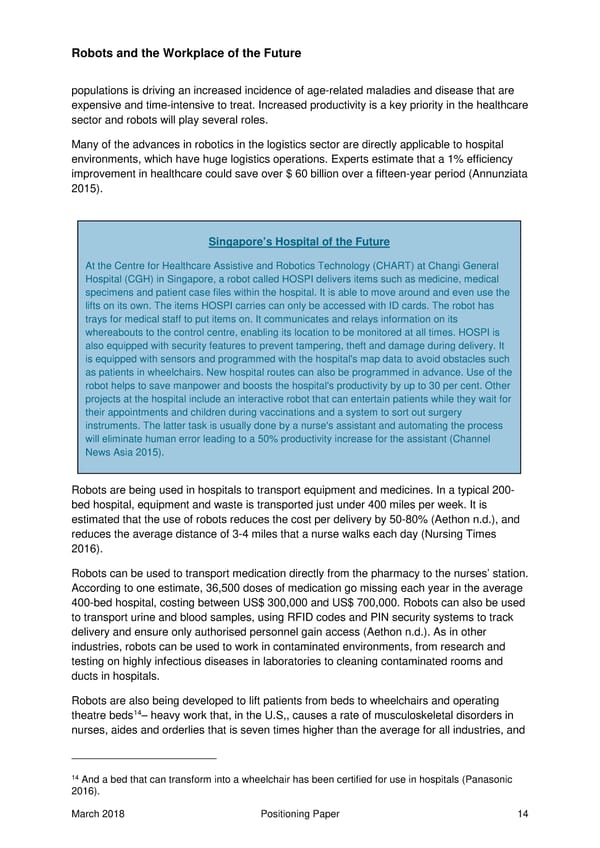Robots and the Workplace of the Future populations is driving an increased incidence of age-related maladies and disease that are expensive and time-intensive to treat. Increased productivity is a key priority in the healthcare sector and robots will play several roles. Many of the advances in robotics in the logistics sector are directly applicable to hospital environments, which have huge logistics operations. Experts estimate that a 1% efficiency improvement in healthcare could save over $ 60 billion over a fifteen-year period (Annunziata 2015). Singapore’s Hospital of the Future At the Centre for Healthcare Assistive and Robotics Technology (CHART) at Changi General Hospital (CGH) in Singapore, a robot called HOSPI delivers items such as medicine, medical specimens and patient case files within the hospital. It is able to move around and even use the lifts on its own. The items HOSPI carries can only be accessed with ID cards. The robot has trays for medical staff to put items on. It communicates and relays information on its whereabouts to the control centre, enabling its location to be monitored at all times. HOSPI is also equipped with security features to prevent tampering, theft and damage during delivery. It is equipped with sensors and programmed with the hospital's map data to avoid obstacles such as patients in wheelchairs. New hospital routes can also be programmed in advance. Use of the robot helps to save manpower and boosts the hospital's productivity by up to 30 per cent. Other projects at the hospital include an interactive robot that can entertain patients while they wait for their appointments and children during vaccinations and a system to sort out surgery instruments. The latter task is usually done by a nurse's assistant and automating the process will eliminate human error leading to a 50% productivity increase for the assistant (Channel News Asia 2015). Robots are being used in hospitals to transport equipment and medicines. In a typical 200- bed hospital, equipment and waste is transported just under 400 miles per week. It is estimated that the use of robots reduces the cost per delivery by 50-80% (Aethon n.d.), and reduces the average distance of 3-4 miles that a nurse walks each day (Nursing Times 2016). Robots can be used to transport medication directly from the pharmacy to the nurses’ station. According to one estimate, 36,500 doses of medication go missing each year in the average 400-bed hospital, costing between US$ 300,000 and US$ 700,000. Robots can also be used to transport urine and blood samples, using RFID codes and PIN security systems to track delivery and ensure only authorised personnel gain access (Aethon n.d.). As in other industries, robots can be used to work in contaminated environments, from research and testing on highly infectious diseases in laboratories to cleaning contaminated rooms and ducts in hospitals. Robots are also being developed to lift patients from beds to wheelchairs and operating theatre beds14– heavy work that, in the U.S,, causes a rate of musculoskeletal disorders in nurses, aides and orderlies that is seven times higher than the average for all industries, and 14 And a bed that can transform into a wheelchair has been certified for use in hospitals (Panasonic 2016). March 2018 Positioning Paper 14
 Robots & the Workplace of the Future Page 14 Page 16
Robots & the Workplace of the Future Page 14 Page 16